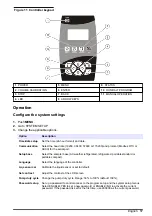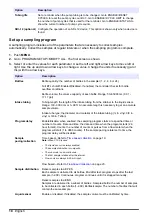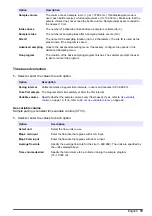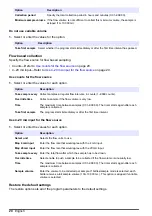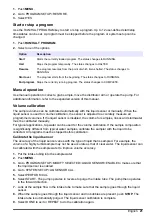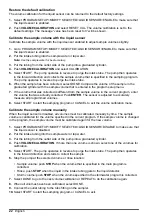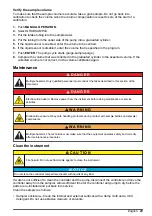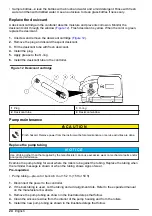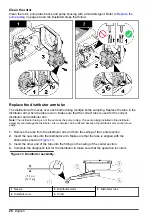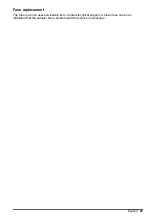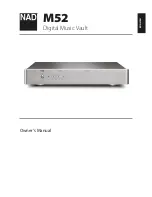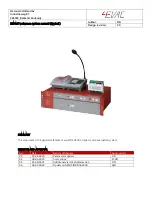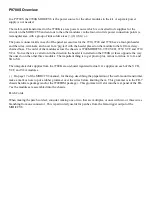
Figure 5 Multiple bottle installation
1
Positioner/retainer (2347)
8
Glass bottles, 3.8 L (1 gal), (4x) (2216) or
polyethylene bottles, 3.8 L (1 gal), (4x) (2217)
2
Retainer (1422)
9
Glass bottles, 1.9 L (0.5 gal), (8x) (1118) or
polyethylene bottles, 2.3 L (0.61 gal), (8x) (657)
3
Retainer (2190)
10
Polyethylene bottles, 1 L (0.26 gal), (24x) (737)
4
Retainer (2189)
11
Glass bottles, 350 mL (11.83 oz), (24x) (732)
5
Glass bottles, 950 mL (32.12 oz) (8x) (2348)
12
Compact base (8975)
6
Polyethylene bottles, 575 mL (19.44 oz), (24x)
(1369)
13
Standard base (8976)
7
Glass bottles, 3.8 L (1 gal), (2x) (2214) or
polyethylene bottles, 3.8 L (1 gal), (2x) (2215)
Plumb the sampler
Install the strainer in the middle of the sample stream (not near the surface or the bottom) to make
sure that a representative sample is collected. Refer to
. Refer to
for the intake tube
installation.
1.
Connect the tubing to the sampler as shown in
Note: Use connection kit 2186 if Teflon-lined tubing is used.
2.
Install the intake tube and strainer in the main stream of the sample source where the water is
turbulent and well-mixed.
• Make the intake tube as short as possible.
• Keep the intake tube at a maximum vertical slope so that the tube drains completely between
samples.
Note: If a vertical slope is not possible or if the tube is pressurized, disable the liquid sensor. Calibrate the
sample volume manually. Refer to
Calibrate the sample volume manually
on page 22.
• Make sure that the intake tube is not pinched.
12
English
Summary of Contents for SD900
Page 2: ...English 3 Fran ais 28 Espa ol 54 Portugu s 80 106 129 153 2...
Page 25: ...English 25...
Page 103: ...Portugu s 103...
Page 109: ...FCC 15 A 1 2 3 4 5 SD900 1 1 1 6 2 7 3 8 4 9 5 10 21 L 5 5 gal 2 109...
Page 111: ...110 106 111 114 106 1 111 2 3 111...
Page 113: ...4 1 1 1 6 2 1 24 7 21 L 5 5 gal 3 1 8 8 4 1 2 4 9 5 1 111 2 1 112 3 5 8 4 8 113...
Page 115: ...6 1 3 2 7 8 115...
Page 117: ...15 A 117 1 2 10 3 117...
Page 118: ...10 50 C 122 F 1 3 5 15 2 11 MENU ENTER BACK 118...
Page 125: ...12 1 12 2 3 4 5 O 6 12 1 3 O 2 4 125...
Page 126: ...4 6 m 15 2 m 15 ft 50 ft 1 2 3 4 5 126...
Page 127: ...126 127...
Page 128: ...1 2 13 3 4 13 1 3 5 2 4 128...
Page 131: ...Web IECS 003 A 131...
Page 133: ...1 1 6 2 7 3 8 4 9 5 10 21 L 2 HACH Japan 2 1 6 2 7 AC 3 8 4 9 5 10 133...
Page 136: ...1 5 137 4 1 1 1 6 2 1 24 7 21 L 3 1 8 8 4 2 2 4 9 5 1 135 2 1 135 3 5 8 1 4 8 136...
Page 138: ...6 1 3 2 7 8 138...
Page 140: ...GFCI GFI 15 A PE 141 AC 140...
Page 141: ...1 2 10 3 10 50 C 1 3 5 15 2 AC 11 MENU ENTER BACK 141...
Page 149: ...12 1 12 2 3 4 5 O 6 12 1 3 O 2 4 149...
Page 150: ...4 6 m 15 2 m 1 2 Web 3 4 5 150...
Page 151: ...150 151...
Page 152: ...1 2 13 3 4 13 1 3 5 2 4 152...
Page 155: ...IECS 003 A 155...
Page 157: ...1 1 6 2 7 3 8 4 9 5 10 21 L 5 5 gal 2 2 1 6 2 7 AC 3 8 4 9 Teflon 5 10 157...
Page 158: ...XXX 1993 4 15 OSHA CFR 1910 146 250 000 19 5 23 5 H2S 10 ppm 158 153 159 161 153 158...
Page 160: ...4 1 1 1 6 2 24 1 7 21 L 5 5 gal 3 8 1 8 4 2 4 1 9 5 1 159 2 1 159 3 5 8 1 4 8 160...
Page 162: ...6 1 3 2 7 8 162...
Page 164: ...GFCI GFI 15 A PE 165 AC 164...
Page 165: ...1 2 10 3 10 50 C 122 F 1 3 5 15 2 AC 11 MENU ENTER BACK 165...
Page 172: ...0 1 MANUAL OPERATION 2 GRAB SAMPLE 3 4 5 6 7 ENTER 8 172...
Page 173: ...12 1 12 2 3 4 5 6 12 1 3 2 4 4 6 m 15 2 m 15 ft 50 ft 1 2 3 4 5 173...
Page 174: ...174...
Page 175: ...173 1 2 13 3 4 13 1 3 5 2 4 175...
Page 176: ......
Page 177: ......

















